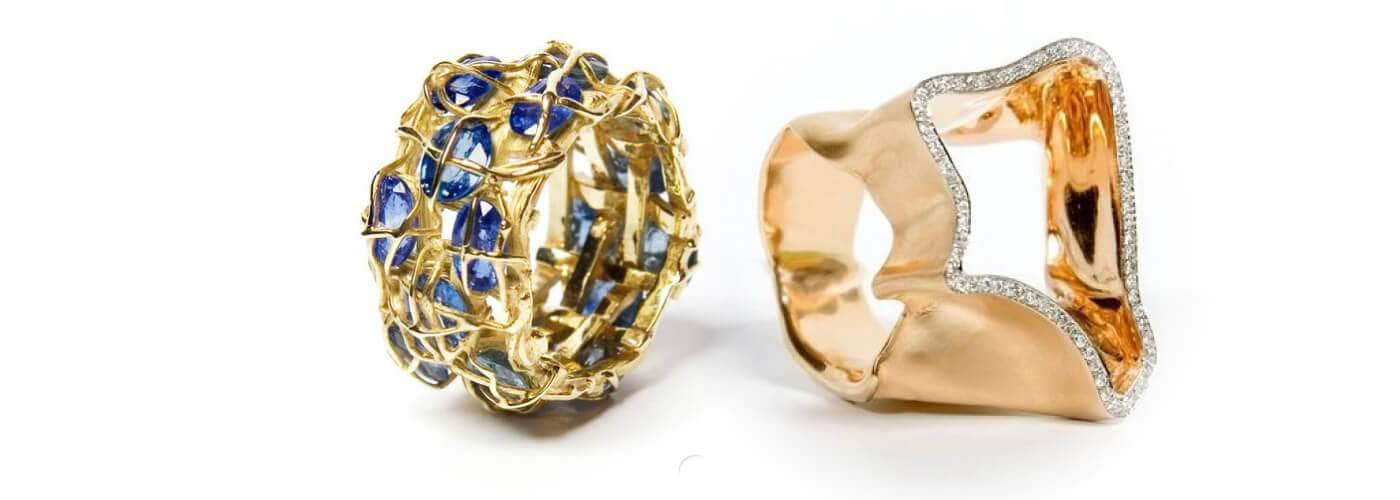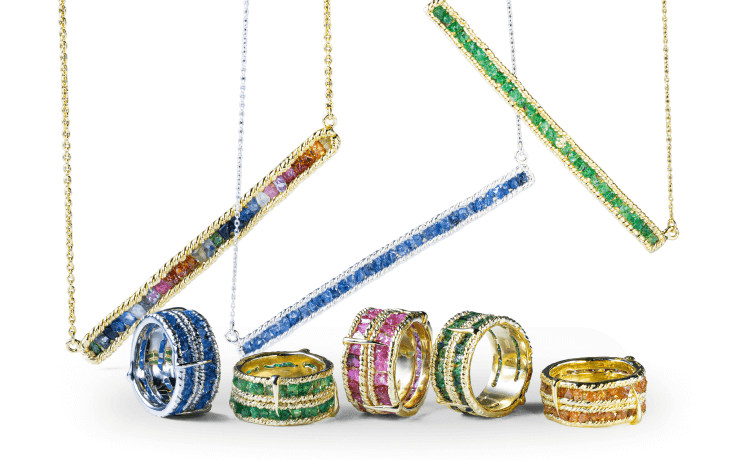Contemporary Gold: Traditions and Modern Jewelry Trends
Awaiting German Kabirski's New Gold Jewelry Collection: Insights into Gold jewelry

As we write this, the anarchist designer German Kabirski is at work on a new gold jewelry collection. While we wait to see what his creative process brings forth this time, let's take the opportunity to delve into a review of gold jewelry. This discussion will explore the rich history and various forms of gold jewelry, clarify the meaning of gold karats, and examine the alloys used in jewelry making, particularly in designer pieces. Join us as we explore these topics, setting the stage for Kabirski's upcoming creations
From Everyday Fashion to Luxury and Designer Statements
Gold remains a popular choice in jewelry, appealing to various tastes and budgets. The modern jewelry market showcases gold in three main forms: mass market, luxury, and designer pieces. Each type offers unique appeal and serves different preferences, from casual accessorizing to exclusive artistry.

Mass market gold jewelry is all about affordability and following trends. These pieces are made in large quantities and often use less pure gold, which helps keep prices low. They're perfect for fashion-forward buyers looking for cost-effective options. In contrast, luxury gold jewelry focuses on high-quality materials and craftsmanship. These pieces use purer gold and include precious gemstones, appealing to those who view their purchases as long-term investments and cherish traditional luxury.
Designer gold jewelry stands out with its quirky and contemporary approach. Here, artists experiment with innovative designs that challenge traditional norms. This jewelry blends artistic expression with the luxury of gold, offering exclusive pieces that serve as personal statements. For those interested in art and fashion, designer gold jewelry provides a creative outlet that distinguishes itself from more conventional offerings.
The Evolution of Gold Jewelry Through the Ages
Gold jewelry has captivated human interest for millennia, serving as a cornerstone in the adornment practices of ancient civilizations across the globe. Its inherent luster and resistance to tarnish made it a preferred material for both decorative and symbolic purposes. From the elaborate burial ornaments of the Pharaohs in Egypt to the intricate golden garlands of the classical Greek and Roman periods, gold has consistently been a medium through which societies have expressed wealth, status, and religious beliefs.
The Middle Ages and Renaissance periods witnessed further evolution in gold jewelry, with the introduction of gemstones and diamonds, adding to the metal's allure. European monarchs and nobility wore elaborate gold pieces as a demonstration of their wealth and power. By this time, goldsmithing techniques had become increasingly sophisticated, incorporating filigree and enameling that enhanced the beauty and value of gold items. Jewelry at this time was not merely decorative but also served as a potent symbol of political alliances and social status.
Moving into the modern era, the industrialization of the 19th and 20th centuries made gold jewelry more accessible to the middle class, marking a shift from exclusively aristocratic possession to a more general symbol of personal achievement and style. This period also saw the rise of major jewelry houses and designers who began to shape gold into the forms we recognize today. Contemporary gold jewelry continues to reflect its rich heritage, blending traditional craftsmanship with modern design techniques, and remains a key element of both personal expression and cultural identity worldwide.
Luxury Gold Jewelry: From Time-Honored Traditions to Modern Marvels
Luxury gold jewelry represents a pinnacle of craftsmanship and exclusivity, where the importance of heritage and meticulous attention to detail are paramount. Traditionally, this segment has been defined by its use of high-quality materials, including high-karat gold and rare gemstones. The allure of luxury jewelry lies not only in its material value but also in the artistry and history it embodies. Each piece tells a story, often passed down through generations or inspired by historical eras of opulence, such as the Baroque or Victorian periods.
Today’s luxury jewelry brands continue to uphold these high standards while incorporating contemporary design elements. Iconic houses like Cartier, Tiffany & Co., and Bulgari have been at the forefront, crafting pieces that offer a modern twist on classic aesthetics. These brands have mastered the art of blending timeless techniques with innovative designs to meet the tastes of today’s discerning consumers. For instance, new cutting techniques for gemstones and experimental alloys have allowed these brands to push the boundaries of traditional luxury jewelry.
The significance of luxury gold jewelry extends beyond its beauty and craftsmanship; it serves as a symbol of status and personal accomplishment. Investing in such pieces often involves careful consideration of their potential to appreciate in value, making them not only items of personal adornment but also financial assets. As a result, luxury gold jewelry remains a cornerstone of sophisticated style and a marker of wealth and refined taste in the modern world.

Affordable Gold: The Rise of Mass Market Gold Jewelry
Mass market gold jewelry has revolutionized the way consumers approach everyday elegance, making gold accessible to a wider audience. Unlike its luxury counterparts, mass market jewelry focuses on cost-efficiency and broad appeal. It often utilizes lower karat gold or gold-plated options, which keeps prices affordable while still offering the allure and appearance of gold. This segment caters to fashion-forward consumers looking for trendy pieces that can be regularly updated to keep pace with changing styles.
The production of mass market gold jewelry is characterized by high-volume manufacturing techniques. Advanced technology and standardized processes allow for rapid production of large quantities, ensuring that the latest designs are readily available to consumers. This scalability helps brands quickly adapt to the latest fashion trends, which keeps them relevant in a fast-paced market. Additionally, the integration of ecommerce platforms has made these pieces even more accessible, allowing consumers to shop the latest trends from the comfort of their own homes.
Despite its affordability, mass market gold jewelry still offers a touch of sophistication and the timeless appeal of gold, which makes it a popular choice for everyday wear and special occasions alike. As consumer preferences continue to evolve, this segment adapts, blending traditional gold jewelry elements with contemporary designs to meet diverse aesthetic and budgetary needs. This approach not only democratizes the beauty of gold but also underscores the metal's enduring appeal in modern fashion.

Introduction to Contemporary Gold Jewelry
Contemporary gold jewelry stands at the vibrant intersection of art and luxury, where creativity and exclusivity forge remarkable pieces often available as one-of-a-kind works. Today's top designers, such as German Kabirski, are pushing the boundaries of traditional jewelry design by integrating novel techniques and materials to express unique artistic visions. This innovative approach marks a significant shift in how jewelry is perceived—not just as an accessory but as a personal statement of art.
Artistic and Creative Expressions
Contemporary jewelry designers view gold not merely as a material but as a canvas for storytelling and creativity. This mindset has led to the emergence of designs that are as diverse as they are expressive, often customized or produced in limited editions to maintain exclusivity. The artistry involved in contemporary gold jewelry goes beyond standard shapes and settings; it experiments with asymmetrical forms, textures that mimic nature, and incorporations of other unconventional materials, making each piece a testament to artistic freedom and innovative thinking.
One-of-a-Kind Luxury
The exclusivity of contemporary gold jewelry often comes from its bespoke nature. Many pieces are Special order or as unique items, ensuring that no two pieces are exactly alike. This one-of-a-kind aspect is highly prized among collectors and fashion enthusiasts who seek to differentiate themselves through unique adornments. Such pieces not only cater to individual style preferences but also enhance the intrinsic value of the jewelry, making it not just an ornament but a personal investment.
The Fusion of Luxury and Art
Modern gold jewelry blurs the lines between luxury goods and fine art. Designers like German Kabirski are at the forefront of this movement, creating pieces that incorporate both high-value materials like gold and the raw, unpolished beauty of gemstones. Kabirski, in particular, is known for his pioneering use of raw gemstones—gems that are kept in their natural, uncut form, which he integrates into sophisticated gold settings. This approach celebrates the inherent beauty of these stones, untouched and unmodified, contrasting dramatically with the refined gleam of polished gold.

Innovative Techniques and Modern Designs
The evolution of contemporary gold jewelry is largely driven by the advent of new techniques and a bold approach to design. German Kabirski and his peers have opened a new chapter in jewelry history, where the focus is on personal expression through innovative forms and textures. These designers often employ methods that challenge the conventional parameters of jewelry making, such as using gold in fluid, organic shapes that wrap around raw gemstones in an almost protective manner. This not only showcases the gemstones in their most natural state but also highlights the malleable versatility of gold.
A New and Exciting Territory
The use of raw gemstones is a radical departure from traditional jewelry design, where the emphasis has typically been on cut and clarity. By choosing to leave these stones in their raw, unmined state, designers like Kabirski are not only celebrating the beauty of imperfection but are also making a statement about the authenticity and raw allure of nature itself. This approach has captivated a new generation of jewelry enthusiasts who value originality and ecological consciousness, setting a trend that melds the past with a bold, new vision of the future.
This thrilling blend of innovation, art, and nature in contemporary gold jewelry is not just redefining what jewelry can be; it's reshaping how we adorn ourselves in the modern world.

Gold Alloys: Material Diversity in Contemporary Designer Jewelry
For designer jewelry, the choice of gold alloy can vary significantly depending on the aesthetic and functional requirements of the piece. Here are some common types of gold alloys used in designer jewelry.
18-Karat Gold
This is one of the most popular choices for designer jewelry due to its ideal balance between purity and durability. Containing 75% gold and 25% other metals, such as copper or silver, 18-karat gold provides a rich color while being hard enough for everyday wear. It's often used in high-end pieces where both luxury appearance and practicality are important.
14-Karat Gold
With 58.3% gold content, 14-karat gold is less pure than 18-karat but offers greater strength and resistance to wear and tear. It's a preferred choice for designer jewelry that needs to withstand frequent use, such as rings and bracelets. This alloy is particularly popular in the United States and parts of Europe.
22-Karat Gold
This alloy, containing 91.7% gold, is favored for its deeper yellow color and sheen, making it a top choice in regions like the Middle East and India. It's less durable than 14- or 18-karat gold but is often used in luxury jewelry that is not intended for daily wear.
White Gold
Achieved by alloying gold with white metals such as palladium or nickel, along with a coating of rhodium for extra whiteness and durability, white gold is a popular choice for contemporary designer jewelry. It offers an alternative to the classic yellow gold and matches well with numerous gemstones, enhancing their visual impact.
Rose Gold
This alloy is made by adding copper to gold, giving the metal a pinkish hue. The exact shade can vary based on the copper content. Rose gold has become increasingly popular in designer jewelry for its warm, unique appearance and its retro yet modern vibe.
Green Gold
Less common but intriguing, green gold is an alloy of gold and silver, sometimes with small amounts of copper. It offers a subtle greenish tint and is used in specialty designer pieces that aim to stand out.
Each of these alloys can be used to create distinct and beautiful pieces of jewelry that reflect the designer's vision and meet the wearer’s preferences for style and functionality.


Gold Karats Explained: Variations in Purity and Preferences Around the World
Gold karats measure the purity of gold jewelry, indicating how much gold is present in the alloy. A karat represents 1/24th of the total metal content, so 24-karat gold is pure gold with no other metals mixed. Most gold jewelry isn’t made from pure gold, as it is too soft for practical wear. Instead, gold is often combined with other metals like silver, copper, or zinc to improve its strength and durability. This mixture not only affects the karat but also the color and hardness of the final product.
Global Variations in Gold Purity
The preference for different karat gold varies significantly around the world, influenced by cultural factors, economic considerations, and local tastes. In the United States and Europe, 14-karat gold is very popular due to its durability and affordability. It strikes a balance between purity and strength, making it ideal for daily wear jewelry that withstands the rigors of modern life. Conversely, in the Middle East and parts of Asia, higher karats like 18 and 22 are preferred for their higher gold content and vibrant yellow sheen, which are often associated with luxury and status.
This global diversity in gold karat preference showcases the cultural richness and variability of jewelry tastes. Whether opting for the rich, pure luster of 24-karat gold in Asian markets or the more durable and toned-down 14-karat pieces in Western countries, consumers choose gold types that best suit their lifestyle, budget, and aesthetic preferences.
Anticipating Innovation: German Kabirski's Forthcoming Gold Jewelry Collection
German Kabirski is currently immersed in the creative process of designing a new gold jewelry collection. Known for his artistic approach to merging uncut gemstones with elegant gold frameworks, Kabirski continues to redefine the boundaries of jewelry design. This collection, being crafted as we discuss the broader context of gold jewelry, is highly anticipated for its innovative and expressive designs. Enthusiasts of artful jewelry and those who appreciate creative mastery are eagerly looking forward to this release, which promises to enrich the landscape of contemporary jewelry with fresh, artistic insights.






Share your comment
This site is protected by hCaptcha and the hCaptcha Privacy Policy and Terms of Service apply.